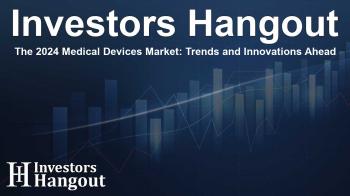The 2024 Medical Devices Market: Trends and Innovations Ahead

2024 Medical Devices Market Overview
Exploring the Dynamic Growth and Regulatory Evolution of the Global Medical Device Industry
Recent insights reveal that the global market for medical devices is gearing up for remarkable expansion. As part of this sector's ongoing evolution, significant technological advancements and rising healthcare expenditures are propelling growth. This article dives into the anticipated trends and key drivers shaping the future of this industry.
Market Projections and Growth Rates
Forecasts indicate that the medical devices market is set to grow impressively. By 2024, the market is expected to reach around $810.4 billion, escalating to approximately $1.3 trillion by the end of 2029. This transition represents a compound annual growth rate (CAGR) of 9.8%. Such growth reflects the increasing reliance on technology to meet healthcare needs.
Similarly, the elder care services and assistive devices market is projected to thrive, expanding from $868.2 billion in 2024 to $1.1 trillion by 2029 with a CAGR of 5.8%. Furthermore, drug-device combinations are anticipated to grow from $129.4 billion to $199.8 billion during the same period, exhibiting a CAGR of 9.1%. These trends underscore a diversified approach to enhancing healthcare delivery.
Key Trends Influencing the Medical Device Market
The medical device sector exemplifies resilience and innovation, even in the face of economic challenges. Here, we explore the factors driving the growth of this vital industry:
1. Economic Resilience and Growth
The medical device industry demonstrates robust growth despite the economic climate. Continuous innovation and the necessity for healthcare improvements have propelled this sector forward, emphasizing its critical role in healthcare.
2. Regulatory Changes
Regulators, particularly in developed markets, strive to enhance healthcare affordability. In the U.S. and Europe, rigorous standards compel manufacturers to innovate continuously. These regulations not only aim to improve patient care but also foster a competitive landscape.
3. Expansion into Emerging Markets
Emerging economies present vast opportunities for growth. With distinct healthcare needs and preferences, these markets are becoming pivotal for the development and distribution of diverse medical devices.
4. Technological Advancements
The demand for cutting-edge medical devices is on the rise. Innovations are characterized by the incorporation of advanced materials and functionalities, ensuring they meet the stringent regulatory demands of modern healthcare.
5. Shift Towards Value-Based Healthcare
Moving towards a value-based healthcare model, there is an emphasis on patient outcomes over traditional volume-based measures. This shift invites more scrutiny on device efficacy and its impact on health outcomes.
6. Leading Companies and Innovators
Prominent players such as Medtronic, Abbott, Johnson & Johnson, Siemens Healthineers, and GE Healthcare are at the forefront of driving market growth. Their continued investment in research and development underlines their commitment to advancing medical technology.
7. Future Outlook for the Medical Device Industry
The medical device market is viewed as a multi-billion-dollar industry with optimistic forecasts. Devices often surpass traditional pharmaceuticals in terms of effectiveness in treating and diagnosing various conditions, signaling a shift in treatment paradigms.
8. Demand for Home Healthcare Solutions
The rise of at-home healthcare solutions reflects changing patient preferences. There is increasing demand for user-friendly devices that cater to individuals without extensive medical training, making healthcare more accessible.
9. Impact of the Global Pandemic
COVID-19 has reshaped many industries, and the medical device market is no exception. While it has presented challenges, it has also accelerated innovation, creating opportunities for addressing post-pandemic healthcare needs.
Conclusion and Future Perspectives
As the medical devices market continues to flourish, it is crucial to monitor emerging trends and innovations. Advances not only reflect technological progress but also the growing demands of healthcare providers and patients globally. Continuous research and adaptation will be vital as the landscape evolves.
Frequently Asked Questions
What is the current projected value of the medical devices market?
The medical devices market is projected to grow from approximately $810.4 billion in 2024 to about $1.3 trillion by 2029.
What are the main factors driving growth in the medical device industry?
Key factors include technological advancements, regulatory changes, and expanding opportunities in emerging markets.
How are regulatory changes influencing the market?
Regulatory changes push manufacturers to innovate, ensuring medical devices are effective and affordable for healthcare consumers.
Which companies are leading in the medical device market?
Notable industry leaders include Medtronic, Abbott, Johnson & Johnson, Siemens Healthineers, and GE Healthcare.
How has the global pandemic impacted the medical device market?
The pandemic has accelerated innovation and adaptation in the medical device sector, leading to significant changes in market dynamics and demand.
About The Author
Contact Addison Perry privately here. Or send an email with ATTN: Addison Perry as the subject to contact@investorshangout.com.
About Investors Hangout
Investors Hangout is a leading online stock forum for financial discussion and learning, offering a wide range of free tools and resources. It draws in traders of all levels, who exchange market knowledge, investigate trading tactics, and keep an eye on industry developments in real time. Featuring financial articles, stock message boards, quotes, charts, company profiles, and live news updates. Through cooperative learning and a wealth of informational resources, it helps users from novices creating their first portfolios to experts honing their techniques. Join Investors Hangout today: https://investorshangout.com/
The content of this article is based on factual, publicly available information and does not represent legal, financial, or investment advice. Investors Hangout does not offer financial advice, and the author is not a licensed financial advisor. Consult a qualified advisor before making any financial or investment decisions based on this article. This article should not be considered advice to purchase, sell, or hold any securities or other investments. If any of the material provided here is inaccurate, please contact us for corrections.

